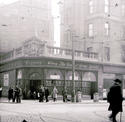 During the First World War, the Defence of the Realm Act (DORA) restricted pub opening hours. Wartime "Munition Ale" - introduced to conserve grain supplies - was much weaker than its pre-war counterpart, and by 1920, duty on whisky, 14s 9d per proof gallon when the war began, had risen to 72s 6d.
During the First World War, the Defence of the Realm Act (DORA) restricted pub opening hours. Wartime "Munition Ale" - introduced to conserve grain supplies - was much weaker than its pre-war counterpart, and by 1920, duty on whisky, 14s 9d per proof gallon when the war began, had risen to 72s 6d.
 In the early 1920s several Glasgow districts, including Cathcart and Whiteinch, became "dry" as ratepayers took advantage of "Local Veto Polls" to vote for local prohibition. The polls, established under the provisions of the Temperance (Scotland) Act of 1913, were abolished in 1976.
In the early 1920s several Glasgow districts, including Cathcart and Whiteinch, became "dry" as ratepayers took advantage of "Local Veto Polls" to vote for local prohibition. The polls, established under the provisions of the Temperance (Scotland) Act of 1913, were abolished in 1976.
 By the 1930s, enterprising city publicans were opening smart lounge bars with art deco features such as chromium-edged bars, indirect lighting and peach mirrors. The new bars welcomed women - when accompanied by men - and served fashionable cocktails such as "White Lady", "Manhattan" and "Angel's Kiss". Glasgow's finest surviving art deco pub, the Portland Arms (1938), 1169 Shettleston Road, is now a listed building. In the Depression-blighted East End, unemployed men were reported to be addicted to methylated spirits. Mixtures of meths and cheap red wine were known as "Jake" or "Johnny Jump Up".
By the 1930s, enterprising city publicans were opening smart lounge bars with art deco features such as chromium-edged bars, indirect lighting and peach mirrors. The new bars welcomed women - when accompanied by men - and served fashionable cocktails such as "White Lady", "Manhattan" and "Angel's Kiss". Glasgow's finest surviving art deco pub, the Portland Arms (1938), 1169 Shettleston Road, is now a listed building. In the Depression-blighted East End, unemployed men were reported to be addicted to methylated spirits. Mixtures of meths and cheap red wine were known as "Jake" or "Johnny Jump Up".
Drink was in short supply in the aftermath of the Second World War, forcing some citizens to take drastic measures, reminiscent of the Depression years. In 1949 eight people died after drinking industrial alcohol at a New Year party in the Blackhill housing scheme.